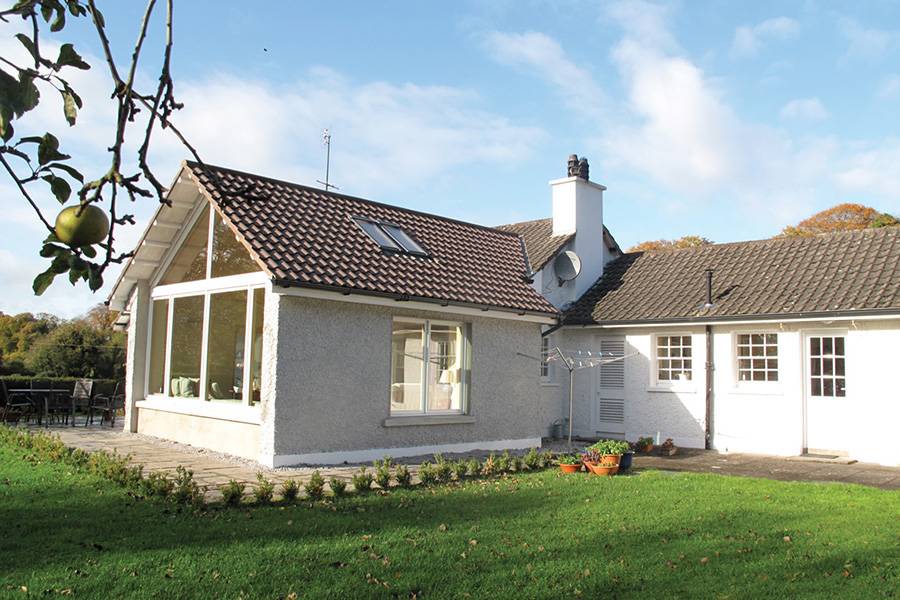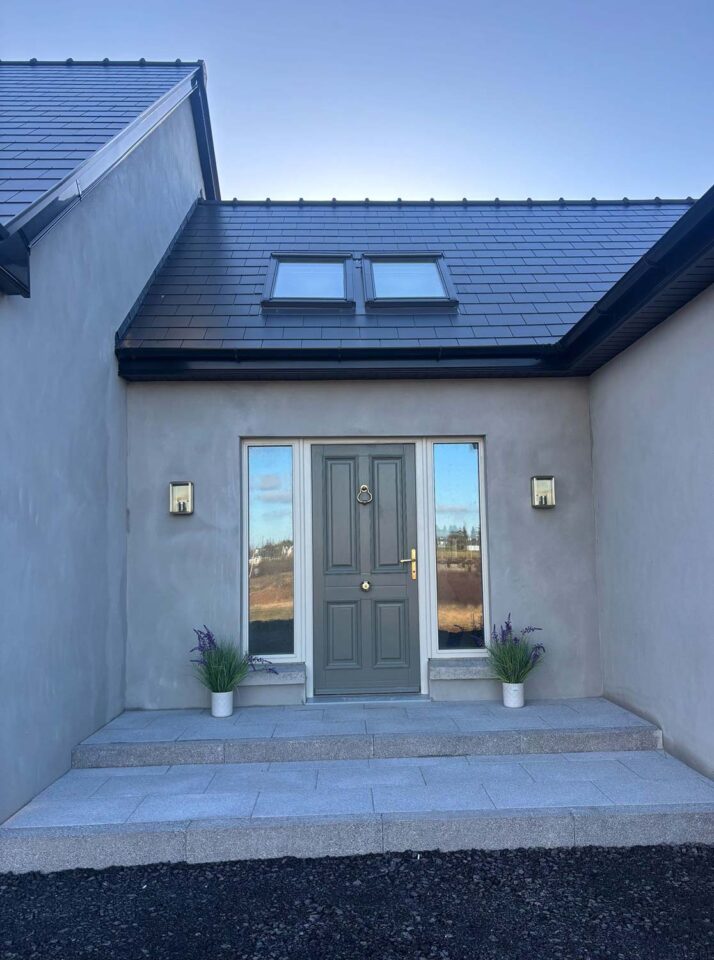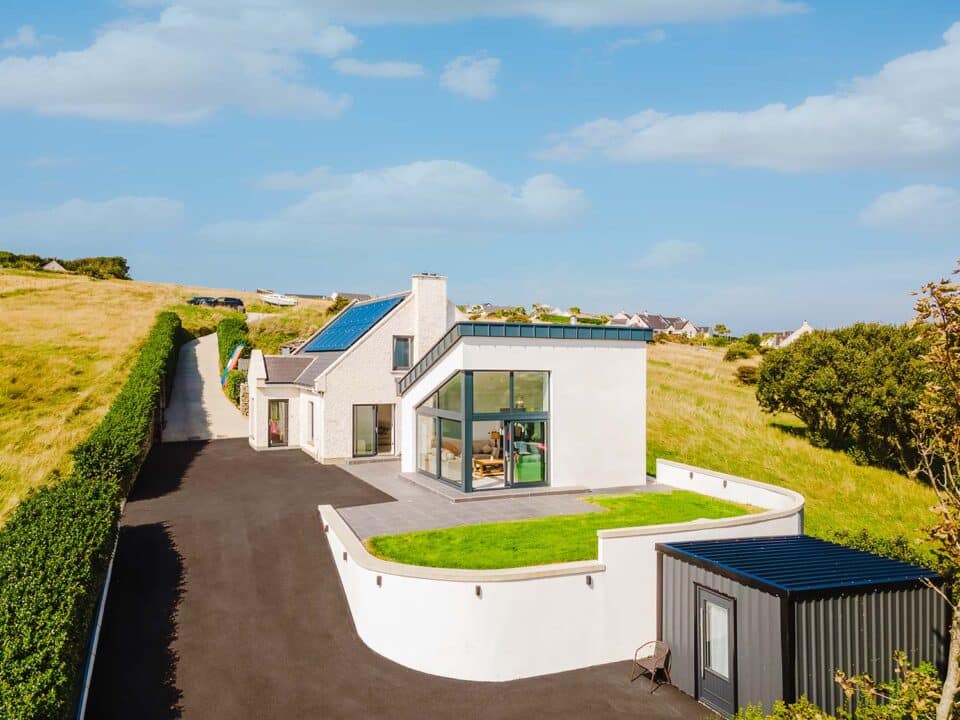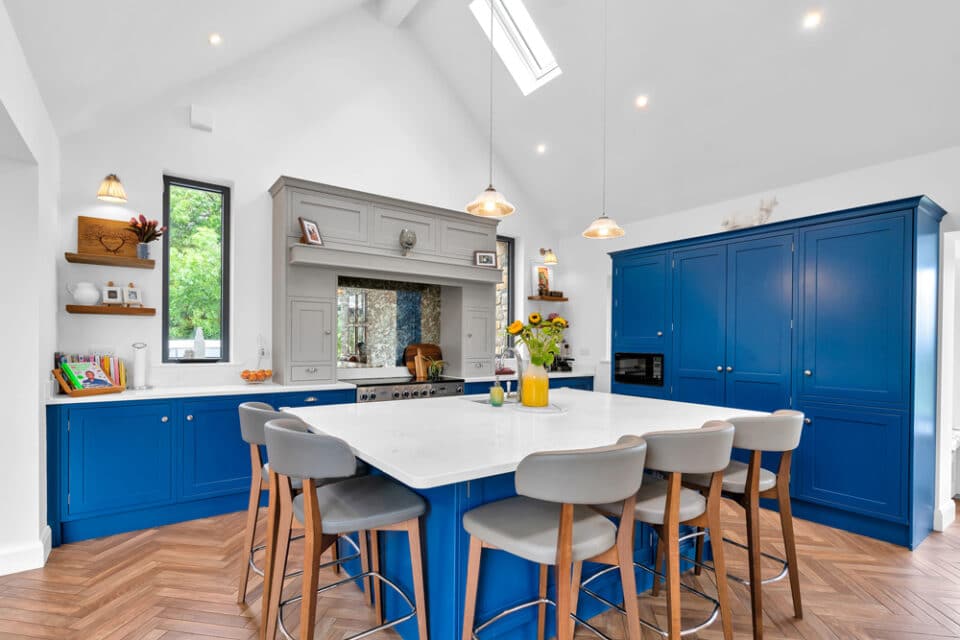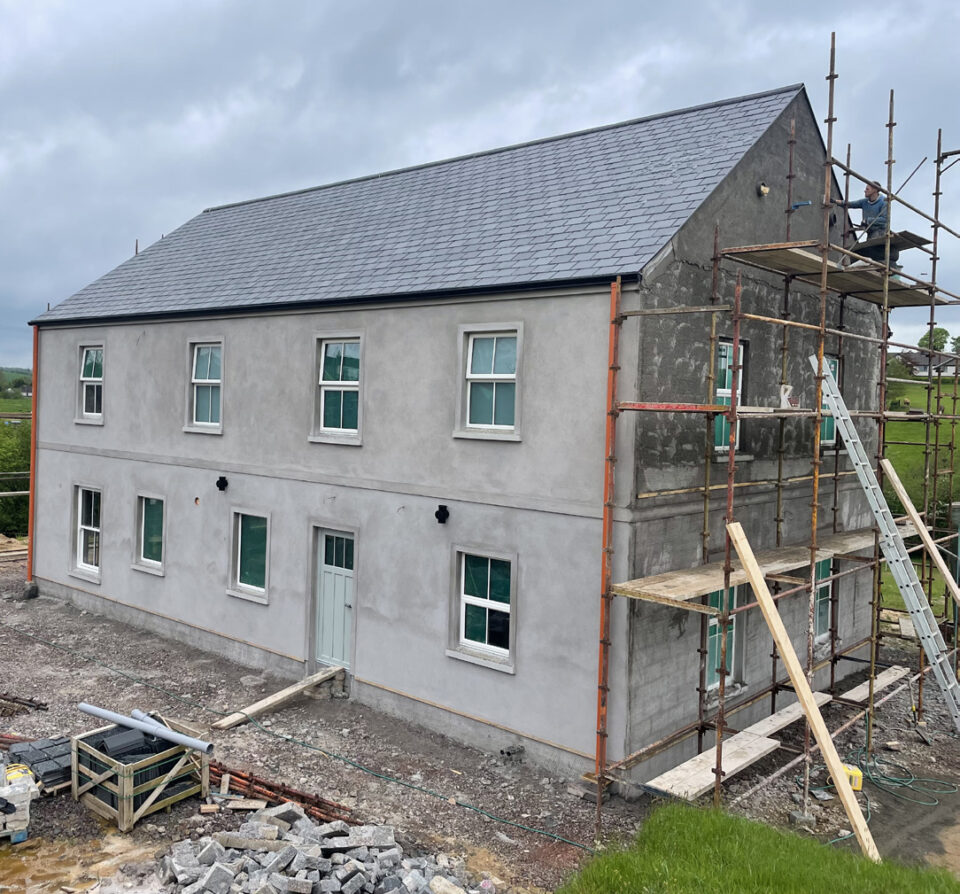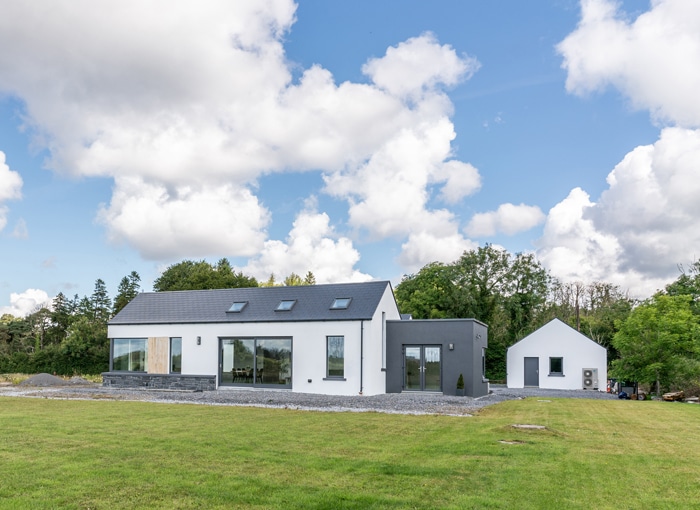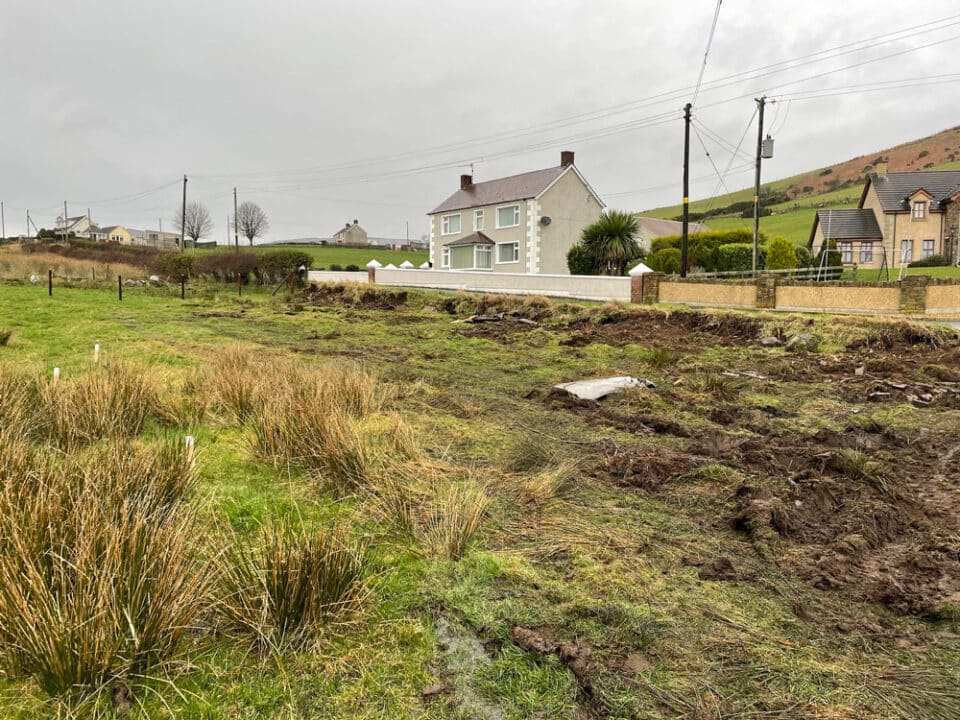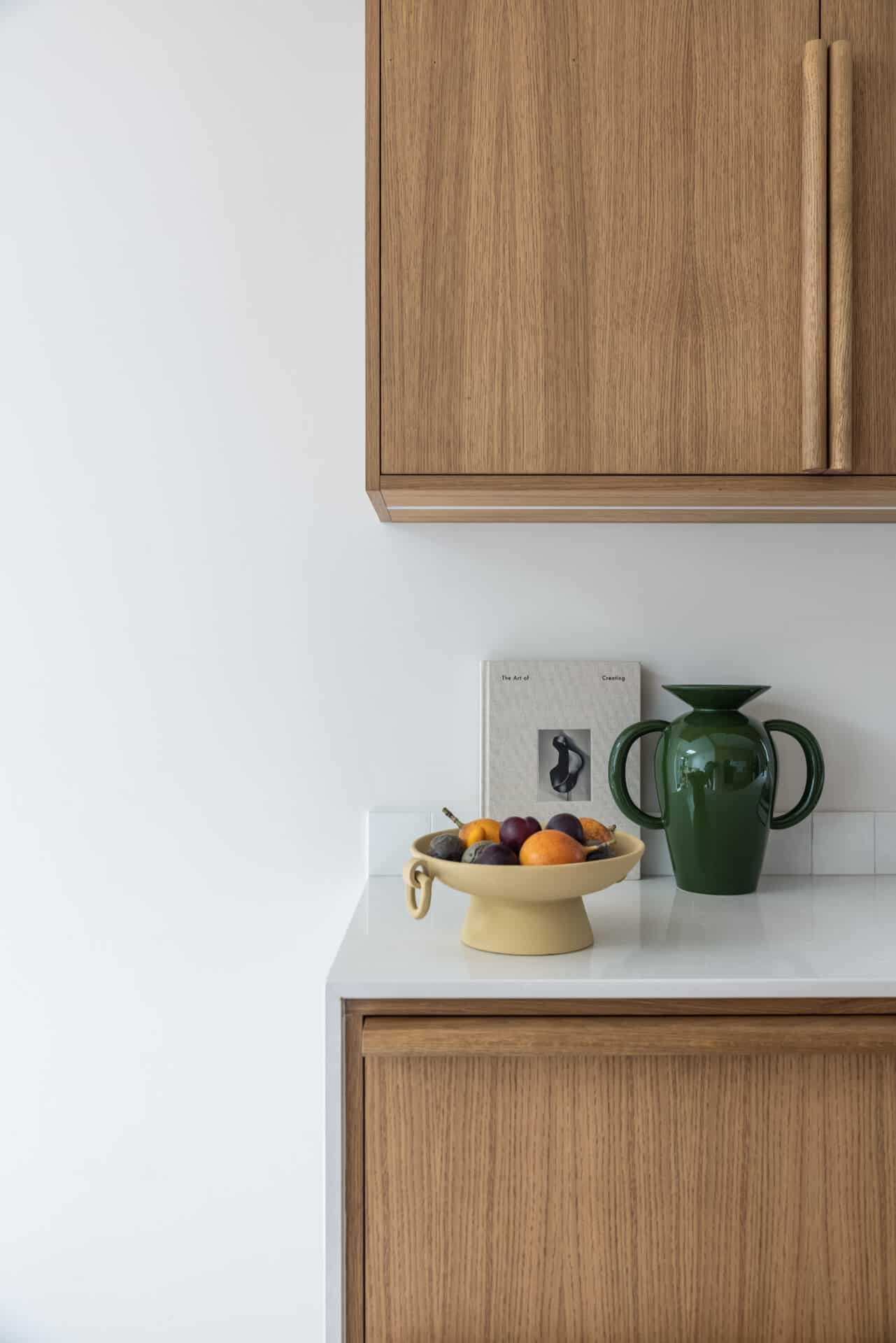[powerkit_collapsibles]
[powerkit_collapsible title=”BUILD SPEC” opened=”true”]
Existing bungalow: 50mm concrete block cavity wall with plaster finish inside and out, EPS beads pumped into wall to give U-value of 0.5 W/m2K; roof upgraded with 300mm fibreglass insulation to give U-value of 0.16 W/m2K.
Extension: wall build up: roughcast cement render to match existing, 100mm solid concrete block, 100mm cavity fully filled with EPS beads, 100mm solid concrete block, 35mm PIR board and plasterboard lining, U-value 0.2 W/m2K. Floor build up: 150mm concrete slab on 100mm PIR board on radon barrier joints lapped and sealed on 50mm sand blinding on 225mm well consolidated hardcore, U-value 0.15 W/m2K. Roof build up: rolled concrete roof tiles to match existing on treated 35 x 50mm counter battens on 35 x 50mm battens on breathable roof felt on 36 x 150mm structural graded joists. PIR insulation 125mm thick between joists, 40mm PIR insulation to underside of rafter. Polythene vapour barrier sealed with proprietary airtightness tapes. T&G V-sheeted boarding to soffit of ceiling, white emulsion “lime” finish and intumescent varnish. U-value 0.16 W/m2K.
Extension size: 20sqm
House size: 2,500 sqft
Build cost: €50,000
Total cost (also includes insulation, electricity, plumbing, furnishings, kitchen): €100,000
[/powerkit_collapsible]
[/powerkit_collapsibles]
“We moved in 24 years ago and raised our four children here,” says Carol. “The bungalow wasn’t very practical but it didn’t take long for us to get used to it. We lived with it and quickly adapted to its eccentricities.”
“But by the time our youngest got to secondary school, we felt we could use more space. We really were living on top of each other! That’s when we decided to build a sunroom. For family life you need space, especially when the children grow up.”
James and Carol met their architect when they were considering a self-build but for various reasons, including the upheaval of moving, they decided to stay put and upgrade the bungalow instead.
Knocking walls down
“When our architect came to the house to discuss our plans, he walked around and questioned the layout. The house wasn’t very well designed, there was a corridor with lots of little rooms, and there was no office – we used to have it in our bedroom so the children, and their clutter, were in there all the time!”
Upon entering the house via the front door, the kitchen and utility areas were all positioned to the left, plus a guest bedroom, with the other bedrooms and living areas to the right.
The boiler room was adjacent to five cubby hole rooms which served little purpose apart from storage and a place to put the washing machine. Walls were knocked down and the space was merged to create just two rooms, a home office and a well proportioned laundry room.
A narrow hallway separated the living quarters from the dining and kitchen area, so there too the wall was knocked down, one of the hallway doors removed and a larger dining space within the kitchen was created. “It used to be very cramped at the kitchen table, we really felt like we were in each other’s way. Now it’s a nice space to be in.”
Home improvements
Carol got much of her inspiration from visiting her friends’ houses. “I love my friend’s kitchen so much I got the same kitchen designer to do ours. The country style works really well here. I used to have a small pokey larder, instead it was incorporated in the new presses.”
“We put new tiles on the floor and redid all the walls as well as the ceiling, neither of which were in very good shape. I chose white and light colours to make the space feel brighter.”
“I would have liked to have an island but there wasn’t enough room, so I added a work surface perpendicular to the galley. The architect didn’t think it was a good idea because it bars entry to the sunroom but I really enjoy baking and this surface is ideal to prepare the dough, it gets plenty of natural light from the sunroom and the granite surface is nice and cool and hard, excellent to work on. ”
“The only drawback is that the granite is porous at the junctions, as there seems to be water getting in around the sink. I called the supplier but he said we’d have to wait and see – as it’s one solid piece we will have to replace the whole lot if it really starts causing trouble.”
“When we moved in the old Aga was already there,” adds Carol, “and when we were changing the kitchen and building the sunroom extension, we thought we might as well hook it up to the heating system.” The old oil boiler was changed to a high efficiency model, but the gravity fed continuous loop circuit from a water tank in the attic was left intact.
“Having looked at the plumbing and replaced the boiler, we decided we should pressurise the system for better water pressure from the taps. This will be our home for life and therefore worthwhile investing in. At times it felt a bit like opening a can of worms!”
“For instance, when we decided to insulate the attic we were surprised to find there were electrical wires sprawled everywhere. The electrician said we should rewire as they were dangerous, so that went on our list as well.”
It’s rather difficult to carry out a total energy upgrade on a house which was never built to be airtight. For example, Carol’s architect highlights the fact that insulating cavity walls isn’t a straightforward exercise – if the wall is very exposed to the elements, there is a high chance of wind-driven rain penetrating it, which is a problem because wet insulation is like having no insulation or worse, as moisture can get trapped. Some finishes, such as exposed brick, may be more porous than others and this would need to be factored in when considering insulating the cavity.
In this case however, the house is sheltered and located inland, reducing the risk, but the twin concrete block leaf cavity was quite narrow at only 50mm, not allowing much insulation to be added. The first 50mm of insulation nevertheless has the biggest effect on an uninsulated wall, the return on further amounts is not as high.
Furthermore, the single glazed sliding sash timber windows may have lots of character and are really interesting to look at, as are the numerous external doors, but a lot of heat gets lost through them too. “I’m currently looking at what I can do to make our windows more energy efficient,” adds Carol. “I didn’t really feel the benefit of the insulation upgrade in our utility bills as we have two large radiators in the extension, so hopefully this will do the trick!”
Sunroom extension
“When we decided to build the extension I knew there would be no television in it,” says Carol. “We have a dedicated TV room already and it would have been distracting to have one in this calm space. This is where the children come to read. I like spending time here listening to the radio and playing bridge on my tablet.”
“Another friend of mine has built a similar extension to what we now have. It brings in so much light! Our architect wasn’t keen on the roof lights but that was one of the aspects I liked about their project and I’m glad we kept them, I love them.”
The upkeep on the rooflights is minimal as the sloped roof allows the water to wash away quickly. The main windows on the other hand, have to be cleaned twice a year. “The bench at the main window area was our architect’s idea and it really works well – it’s where the children sit when they spend time here. They’re either there or in the office using the computer.”
The sunroom specification is relatively standard, up to current building regulation requirements, but thanks to the amount of south facing glazing and the two radiators, the room stays warm and cosy in the winter and provides plenty of light in all seasons. The height of the glazed apex allows low winter sun to penetrate the room whilst the patio doors provide ample ventilation for when it gets too hot – which rarely happens!
“We went to tender for the main building works on the extension and the builder who came in at the best price was the one our architect recommended, he had worked with him before and spoke highly of him. I was very impressed by the quality of his work and how quickly he got it all done. He was very neat and on budget, I can’t praise him highly enough.” They didn’t need to get planning permission as the extension is less than 40sqm.
“We built during the summer of 2011,” adds Carol, “moving out whilst the build was taking place. Quite a bit of work was done and if we had stayed we would have had to cloister ourselves in the bedroom! We would have had no kitchen, no utility. I’m glad we weren’t here because when we came back the entire house was coated with a film of dust, including the bedrooms.”
“The project started in July and finished in September and as our daughter was in boarding school it didn’t disrupt her schedule.”
“During those two months I came down once a week and at times really felt the pressure to find exactly what I wanted very quickly! The tiles were important to me; I was told dark tiles wouldn’t be a great idea as they are difficult to keep clean. I definitely didn’t want porcelain tiles – not only are they impossible to keep clean, they’re slippery too. My son helped me through this stage, coming down with me to various suppliers to find the right ones. Thanks to him we did it within the time frame we were given.”
The softwood sheeting (coated with an emulsion limewash) on the ceiling required some snagging as the timber hadn’t been left to dry out in the room with the heat on, with inevitable consequences. “After a while the timber shrank and gaps started appearing between the boards. Our builder ingeniously filled them with a putty tinted the same colour as the wood so you don’t notice it. Well I do but no one else seems to!”
External cohesion
Viewed from the outside, the extension looks as if it has always been there, the roof tiles and render match in so well. The shape of the sunroom, meanwhile, adds to the building, balancing the sprawling layout of the bungalow. Its large windows, albeit modern, don’t detract from the original house but rather enhance it.
“We chose to put gravel around the house and then put in some flagstones to create a new patio area,” says Carol. “It’s very pleasant out there in the summer time, the view of the woods is fantastic.”

